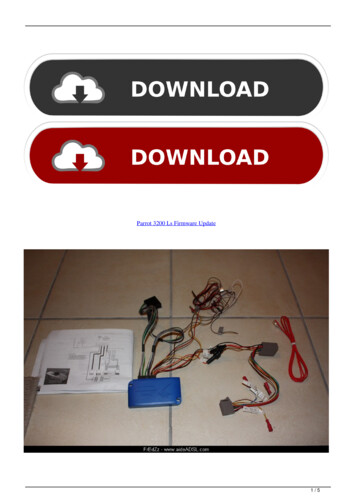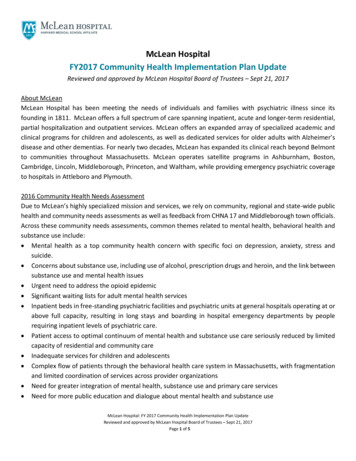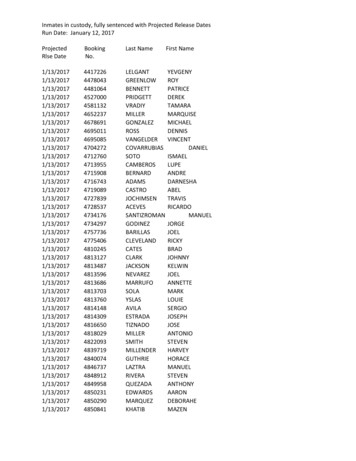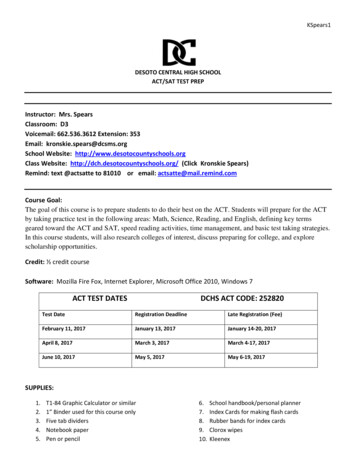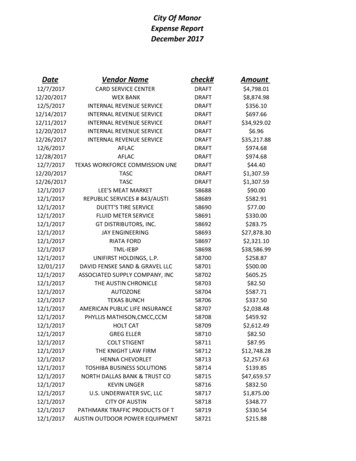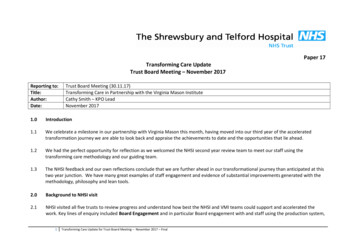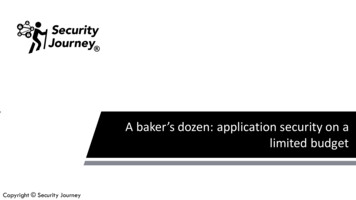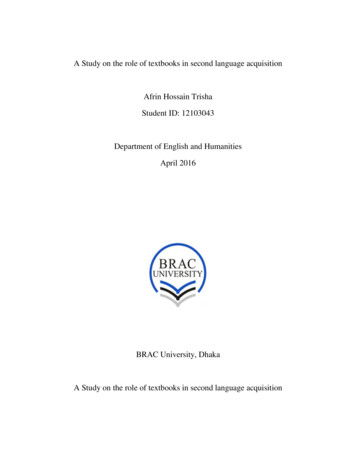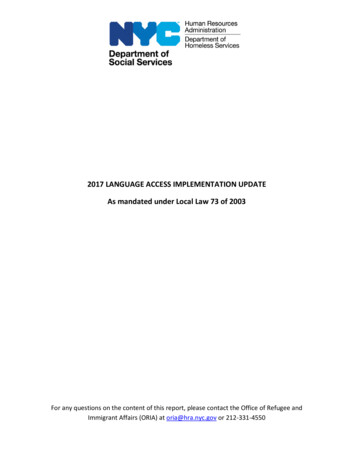
Transcription
2017 LANGUAGE ACCESS IMPLEMENTATION UPDATEAs mandated under Local Law 73 of 2003For any questions on the content of this report, please contact the Office of Refugee andImmigrant Affairs (ORIA) at oria@hra.nyc.gov or 212-331-4550
HRA ClientsIn 2016, HRA served just over 2 million families, approximately one-third of whom were limited Englishproficient (LEP).HRA’s 2016 LEP Caseload2016Total number of case heads (not clients)2,028,652640,349Total number of case heads identified as LEP(32% of total)220,281Total number of non-Spanish LEP case heads(11% of total)Total number of languages spoken942016 LEP Case HeadsSpanish, 420,068Mandarin, 81,347Russian, 34,942Cantonese,28,898All others, 19,020Bengali, 10,179Polish, 2,755Haitian Creole,4,879Urdu, 5,440Arabic, 8,126Korean, 8,510Chinese-Other,18,940
DHS ClientsIn 2016, DHS served approximately 90,000 case heads and more than 7,800 DHS residents werelimited English proficient (LEP).DHS’s 2016 LEP Cases2016Total number of case heads (not clients)90,8577,865Total number of case heads identified as LEP(9% of total)1,155Total number of non-Spanish LEP case heads(1% of total)Total number of languages spoken292016 LEP DHS CasesSpanish, 6,710French, 322"Other", 306Russian, 111Korean, 23Cantonese, 23Polish,68Mandarin, 52Hindi, 78HaitianCreole, 77Arabic, 95
Limited English Proficient (LEP) Clients by Family IndependenceAdministration (FIA) CentersHRA 2016 Limited English Proficient (LEP) Cases by SNAP CenterSNAP CenterTotal CasesLEP Cases% LEPSupplemental Security Income (SSI) SNAP 15190,91567,09735%Concourse SNAP 4580,65433,38341%Queens SNAP 5375,67738,98952%Coney Island SNAP 2274,34828,41738%Crotona SNAP 4673,18120,98729%East New York SNAP 2867,97110,02915%Jamaica SNAP 5466,11812,70819%Fort Greene SNAP 2050,8317,08814%Hunts Point SNAP 4049,52015,22331%St. Nicholas SNAP 1436,8929,79627%Waverly SNAP 1934,2469,57228%North Brooklyn SNAP 2631,4393,89612%Williamsburg SNAP 2131,2438,41227%East End SNAP 0231,0455,68018%Richmond SNAP 9928,7514,13514%Washington Heights SNAP 1324,95514,93560%Rockaway SNAP 7916,4292,57816%Residential Facilities SNAP 6110,8301471%HRA 2016 Limited English Proficient (LEP) Cases by Job CenterJob CenterTotal CasesLEP CasesFamily Services Call Center 1722,1719,704Rider 3820,7353,709Crotona 4620,2873,481Clinton Hill 6719,353780Dekalb 6417,630673Fordham 4417,6083,362Bushwick 6616,9291,412Jamaica 5416,1571,880Dyckman 3515,6083,210Queens 5311,6433,993East River 3710,805826Seniorworks 8410,5805,071Richmond 9910,3631,234Coney Island 6310,2951,413Waverly 1310,218437Hunts Point 409,9571,507East End 239,099591St. Nicholas 188,502870Bay Ridge 707,1011,931Union Square 396,915270Residential Treatment Service Center 525,94154Rockaway 795,504276Refugee & Immigrant 474,8634,111Special Projects 803,32235Veterans 622,40373Home Visit Needed/RAR 902,341491Centralized Rent Processing Unit 71411% %27%4%1%5%85%1%3%21%2%
DHS 2016 Limited English Proficient (LEP) Casesby Shelter Type and BoroughAdult Families SheltersBoroughTotal CasesLEP Cases% 4826%Bronx1,274635%Staten Island000Families with Children SheltersBoroughTotal CasesLEP Cases% 567209%Manhattan7,1215738%Staten Island345268%Single Adult SheltersBoroughTotal CasesLEP Cases% nx5,3014633%Queens3,7872842%Staten Island2110%
Bilingual StaffIn HRA and DHS offices, language services are usually provided through the use of the bilingual staff ortelephonic interpretation services. Together, the agencies have more than 2,100 staff members whospeak a language other than English. Collectively, our staff speaks 128 languages.DSS’s Bilingual Staff (as of n boArabicIboMalayalamNigerian Pidgin dgin EnglishTamilYiddishAmerican Sign Language (ASL)PatoisAll others (94 languages)TOTALNumber of bilingual ual staff members speaking more than one language are counted twice.
Telephonic InterpretationOne of the primary ways that HRA and DHS provide language services is through telephonicinterpretation. Using two different vendors, all of HRA and DHS’s front-line and client-serving staff haveaccess to telephonic interpretation services in approximately 200 languages, 24 hours a day, 7 days aweek.In 2016, HRA used telephonic interpretation services more than 218,000 times, which is an average of840 calls per business day. The 27% increase in the use of telephonic interpretation since last year is aresult of an increase in use by the Supplemental Nutrition Assistance Program (SNAP) and Infoline, theAgency’s call center.HRA's Use of Telephonic 0402010201120122013201420152016
In 2016, DHS used telephonic interpretations approximately 9,000 times, which is an average of 34 callsper business day. Since 2014, there has been a 210% increase of calls made to its telephonicinterpretation services.DHS's Use of Telephonic Interpretation2014 - 3,0002,8882,0001,0000201420152016
On-Site InterpretationHRA uses on-site interpretation services for field visits, visits to homebound clients, and publicpresentations. In a limited number of instances, on-site interpretation is used for office visits.DHS currently does not have an on-site interpretation services contract. In 2017, we will pursue theexpansion of on-site interpretation services to DHS locations.HRA's Use of On-Site Interpretation2013 - 00500020152016
Written TranslationsHRA's Number of Documents Translated 2010 - 020038943020102011534544201220130201420152016DHS's Number of Documents Translated 2013 - 20161615141210876542302013201420152016
Language Access Plan UpdateA full copy of HRA’s 2016 Language Access Plan can be found on HRA’s web site (nyc.gov/hra), by clickingon “I Need Help” and then “Immigrant Resources.” DHS’s original 2015 Language Access Plan can befound on DHS’s web site (nyc.gov/dhs), by clicking on “About” and then “Language Law Access Plan.”Below, is an update on the Agency’s Language Access goals.GoalMethodUse selectivecertification bylanguageIncrease availability ofbilingual staff servicesRecognition of currentbilingual staffImprove signage for LEPclientsRedesign posters toinclude mandated andadditional Agencylanguages.The use of directionalsignageProcessDetermine which civilservice titles eligible forselective certification bylanguage.Develop plan toincrease use of selectivecertification bylanguage.Hire more staff throughselective certification bylanguage.Conduct survey togauge the number ofbilingual staff.Distribute certificates ofappreciation to bilingualstaff.Conduct a secondsurvey to gauge thenumber of bilingualstaff.Distribute a secondround of certificates ofappreciation to HRAbilingual staff andinclude DHS staff.Redesign the currentfree interpretationposter to includeinformation on how tofile a complaint in all 20languages currentlylisted.Post the redesignedfree interpretationposter in all clientserving locations.Rollout multilingualsignage to all DHSlocations.Consider newdirectional signage atStatusComplete – HRAOct. 2017 – DHSComplete – HRANov. 2017 – DHSOngoing – HRA/DHSComplete – HRAN/A – DHSComplete – HRAN/A – DHSComplete – HRA/DHSJuly 2017 – HRA/DHSComplete – HRA/DHSComplete – HRAJuly 2017 – DHSOngoing – DHSOngoing – HRA/DHS
Review, update and/ordevelop procedures toassist LEP clientsDevelop tools to assiststaff in accessingservicesImprove processes toprovide languageservicesIncrease the use oftechnology to providelanguage servicesEnhance our currentmonitoring practiceImprove languageservices delivery acrosscontracted vendorsImprove telephonicinterpretation servicesand access for LEPclientsHRA and DHS locations.Update proceduresregarding thetranslation of clientdocuments into the 9languages.Update LEP trainingsused by variousprogram areasDevelop ReferenceGuides for LanguageLiaisons in HASA, APSand IREA programs,which will facilitate staffto find and access toolsneeded to providelanguage services toclients.Pilot on-demand videoconferencingtechnology to providesign languageinterpretation, allowingclients to immediatelyaccess services ratherthan needing to returnto a Center.Translate new pages onthe ACCESS NYCwebsite, including newonline application formsand featuresReview on sitemonitoring process andconsider modificationto improve oureffectivenessConduct calls to surveyLEP customers/clientson their HRA experienceIncrease the languagecapacity of the Agency’soutgoing robo-calls.Consider increasing thelanguage capacity of theAgency’s current IVRsystem.Provide multi-lingualaccess to the new ondemand SNAPtelephone interviewprocess.Complete – HRAOngoing – DHSComplete – HRA/DHSDec. 2017 – HRAN/A – DHSComplete – HRAN/A – DHSOngoing as Access NYCexpands.Ongoing – HRA/DHSJuly 2017 – HRAN/A – DHSComplete – HRAN/A—DHS2019 – HRA/DHSComplete –HRAN/A—DHS
Improve and expandon-site interpretationservicesImprove writtentranslationsImprove and expandsign language servicesEnhance trackingmechanisms for betterservice provisionInform the public offree language servicesInclude a notice of freelanguage services inapplication andrecertification packets.Use of social mediaWork with current onsite interpretationvendor to improveservice delivery.Pursue expanding onsite interpretation toDHS locations.All client-servingprograms will ensurethat all Agencydeveloped clientdocuments andessential publicdocuments aretranslated into the LocalLaw 73 languages andthe Agency’s additionalthree languagesAdd Local Law 30languages to writtentranslations.ORIA will performperiodic quality reviewsto ensure clientdocuments aretranslated accurately.Conduct refreshertrainings to allow forbetter use of signlanguage interpretationservices across offices.Improve tracking ofclient language in bothDHS and HRAORIA will meet with allprogram areas todetermine whethertheir applicationsinclude a notice of freeinterpretation. A noticewill be developed andadded to applicationkits where necessary.Add Local Law 30languages to notice offree language servicesto all application andrecertification package.ORIA will meet with allHRA program areas fora second time.Use several socialComplete –HRAN/A—DHSN/A—HRADec. 2017—DHSComplete – HRADec. 2017 –DHSJuly 2018 – HRA/DHSOngoing – HRA/DHSOngoing—HRA/DHSOngoing – HRA/DHSComplete—HRAAug. 2017 –DHSJuly 2018 – HRA/DHSAug. 2017 – HRAOngoing – HRA/DHS
Conduct outreach tocommunity-basedorganizationsImprove the Agency’suse of plain languageIncrease the Agency’sonline and social mediapresenceUse of plain languagestandardsIncrease use of socialmedia and web-basedplatforms duringoutreach campaignsIncrease accessibility toonline resources for LEPcommunity membersmedia tools to informLEP New Yorkers abouttheir right to freelanguage services.Meet with communitybased organizations andstakeholders in diversecommunities across theCity.Develop Agency-wideplain languagestandards.Review all new andrevised notices/formsusing our Agency-wideplain languagestandards.Create a SNAPcampaign that raisesawareness about theprogram in New York’sdiverse immigrant andLEP communities.Improve the design andfunctionality of theAgency’s website.Add Local Law 30languages to our publicwebsites.Ongoing – HRA/DHSComplete – HRADec. 2017 – DHSOngoing – HRAPending – DHSComplete – HRAN/A – DHSComplete – HRASpring 2018 – DHSJuly 2018 – HRA/DHS
DHS 2016 Limited English Proficient (LEP) Cases . by Shelter Type and Borough . Adult Families Shelters . Borough Total Cases LEP Cases % LEP Manhattan 1,885 118 6% Queens 1,833 115 6% Brooklyn 1,384 82 6% Bronx 1,274 63 5% Staten Island 0 0 0 . Families with Children Shelters . Borough Total Cases LEP Cases % LEP
